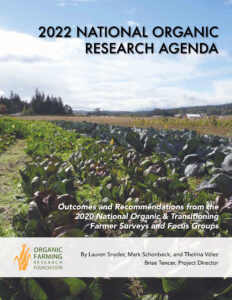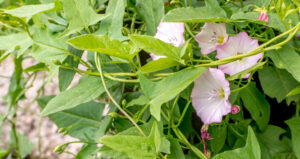 The Organic Farming Research Foundation 2022 National Organic Research Agenda (NORA) is a report informed by surveys and focus groups conducted in 2020 with over 1,100 certified organic farmers and ranchers across North America.
The Organic Farming Research Foundation 2022 National Organic Research Agenda (NORA) is a report informed by surveys and focus groups conducted in 2020 with over 1,100 certified organic farmers and ranchers across North America.
What Farmers Said
- In the NORA report, two-thirds of survey respondents (67%) cited weed management as a substantial production challenge.
- Specific feedback from organic farmers also underscores the need for additional research on controlling weeds such as bindweed.
Knowing Your Weeds
Farmers and researchers alike acknowledge that weeds pose the greatest barrier to building healthy soils in organic cropping systems. Management of weeds in an organic cropping system involves integration of many separate management tactics. Which tactics you use will depend on the weed species present, the crop, the time of year the crop is planted, the type of equipment you have available, other crops in the rotation, and other site and operation-specific factors.
Managing Bindweed
 Field bindweed prefers full sunlight and moderately dry to dry conditions. It is relatively drought tolerant and flourishes in poor soil that contains sand, gravel, or hardpan clay. It is a competitive and persistent weed in a wide range of crops and rangelands. In organic systems the common method for controlling field bindweed is persistent and consistent tilling, requiring cultivation every two – three weeks over a multi-year period.
Field bindweed prefers full sunlight and moderately dry to dry conditions. It is relatively drought tolerant and flourishes in poor soil that contains sand, gravel, or hardpan clay. It is a competitive and persistent weed in a wide range of crops and rangelands. In organic systems the common method for controlling field bindweed is persistent and consistent tilling, requiring cultivation every two – three weeks over a multi-year period.
In systems that work to enhance soil health it is recommended to reduce the frequency of tillage, which can be at odds with management strategies for bindweed infestations. Farmers working toward sustainable conservation tillage systems may first need to take steps to control a current infestation of weeds such as bindweed before returning to reduced tillage practices. Once control of bindweed is achieved, efforts should return to restoring soil health with reduced soil disturbances.
To reduce the impact of field bindweed on production, farmers can:
- Execute a thorough, well-timed tillage program.
- Remove via flame weeding.
- Implement shading techniques.
- Control via soil solarization.
Once control of bindweed is achieved, efforts should return to restoring soil health. The following steps are key to soil health:
- Keep the soil covered
- Maximize living roots in thesis profile
- Minimize soil disturbance
- Energize the system with biodiversity
For more on weed management and applicable solutions that control this common weed, farmers can download OFRF’s Weed Management Guide and Weed Profile on Bindweed.


